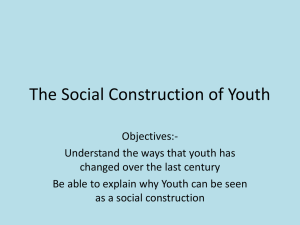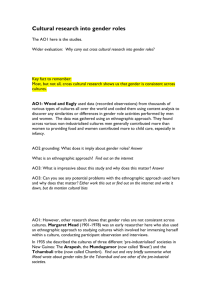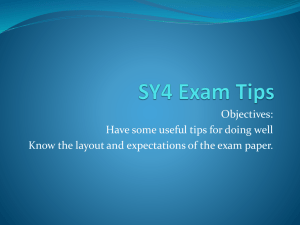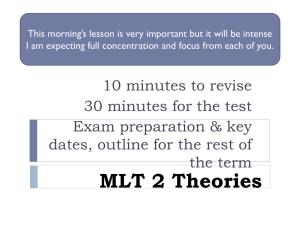revision booklet SY1
advertisement
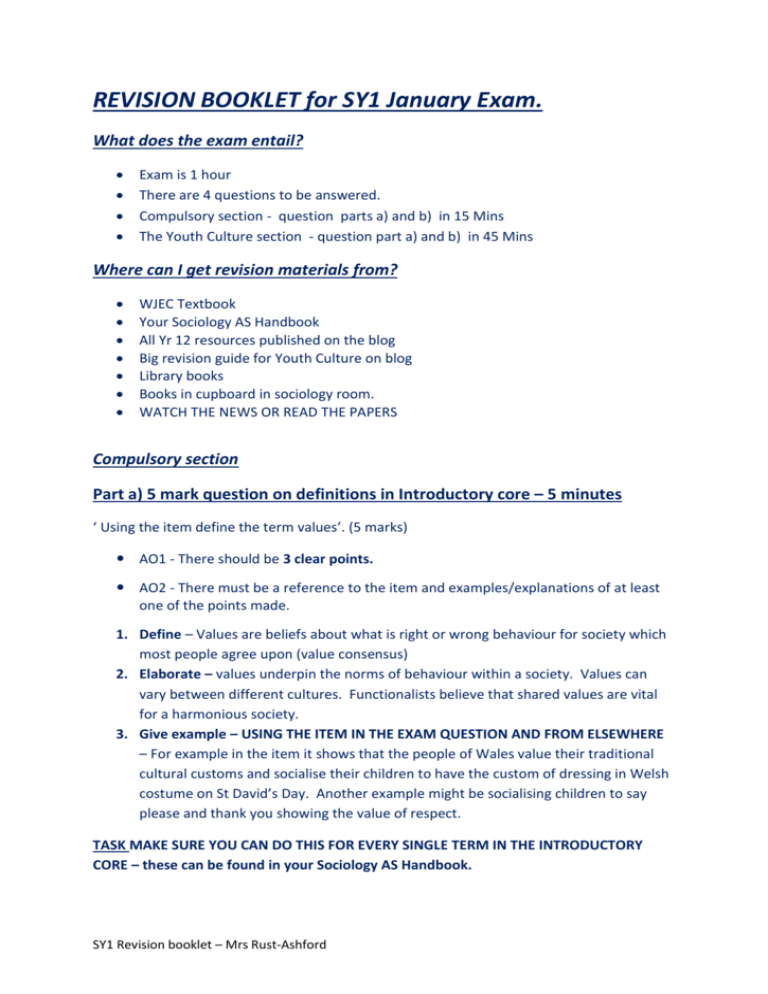
REVISION BOOKLET for SY1 January Exam. What does the exam entail? Exam is 1 hour There are 4 questions to be answered. Compulsory section - question parts a) and b) in 15 Mins The Youth Culture section - question part a) and b) in 45 Mins Where can I get revision materials from? WJEC Textbook Your Sociology AS Handbook All Yr 12 resources published on the blog Big revision guide for Youth Culture on blog Library books Books in cupboard in sociology room. WATCH THE NEWS OR READ THE PAPERS Compulsory section Part a) 5 mark question on definitions in Introductory core – 5 minutes ‘ Using the item define the term values’. (5 marks) AO1 - There should be 3 clear points. AO2 - There must be a reference to the item and examples/explanations of at least one of the points made. 1. Define – Values are beliefs about what is right or wrong behaviour for society which most people agree upon (value consensus) 2. Elaborate – values underpin the norms of behaviour within a society. Values can vary between different cultures. Functionalists believe that shared values are vital for a harmonious society. 3. Give example – USING THE ITEM IN THE EXAM QUESTION AND FROM ELSEWHERE – For example in the item it shows that the people of Wales value their traditional cultural customs and socialise their children to have the custom of dressing in Welsh costume on St David’s Day. Another example might be socialising children to say please and thank you showing the value of respect. TASK MAKE SURE YOU CAN DO THIS FOR EVERY SINGLE TERM IN THE INTRODUCTORY CORE – these can be found in your Sociology AS Handbook. SY1 Revision booklet – Mrs Rust-Ashford Part b) 10 mark question on cultural transmission/socialisation/identity formation. – 10 minutes ‘Using the item and your own knowledge explain how any two agents of socialisation influence gender identity’ (10 marks). AO1 - There should be 4 points made showing knowledge and accurate and appropriate use of sociological terms should be evident for full marks. AO2 - At least 3 of those points will be explained with examples or reference to the item. 1. Define – Socialisation is the process of passing on culture from one generation to the next. Gender identity is our sense of being either masculine or feminine and tells us the norms of behaviour including roles and status appropriate for our sex e.g housewife or breadwinner. 2. Elaborate – AO1 Socialisation is split into primary and secondary and is carried out by various agents – family, peers, media, religion, education, workplace. Functionalists believe socialisation into shared culture is vital AO2 However Marxists believe it serves the bourgoiesie. Gender identity can be seen as socially constructed and feminists believe that women are socialised to feel inferior to men and that society is patriarchal. 3. Using the item in exam question explain how one agent socialises us – AO1 Primary socialisation takes place in the family. Parents act as role models to their children e.g children see that father goes to work and mother does domestic chores. Children imitate their parents behaviour and identify with their same sex parent. Parents also use positive and negative sanctions i.e. punish a boy for crying or praise a girl for nurturing behaviour which teaches them to behave in gender specific ways. AO2 However Oakley mentions how childrens’ activities are canalized according to gender e.g trains for boys and dolls for girls and this socialises them into particular roles which feminists say benefits males. In the item boys are moving tables in the school hall whilst the girls are cleaning chairs. This shows how socialisation encourages the belief that girls are weaker than boys. 4. Using the item explain how another agent socialises usAO1 Education is an important agent of socialisation which contributes to gender identity. At school we learn in two ways – through formal and ‘hidden curriculum.’ Teachers role model certain appropriate behaviours and children learn their gender identity by imitating them. Furthermore teachers might recommend certain career paths e.g engineer or nurse which are gender specific. Teachers also use sanctions to encourage gender specific behaviour e.g praising boys for being strong and girls for being kind. AO2 In the item it states that girls were punished for bringing snails into the classroom as they were dirty whereas it was acceptable for boys to handle them. This shows how teachers unwittingly encourage traditional gender roles and socialise young people. SY1 Revision booklet – Mrs Rust-Ashford TASKS Complete essay plans like this for GENDER, ETHNICITY, SOCIAL CLASS. Bullet point ways that the six agents of socialisation, family, media, peer groups, education, religion and workplace influence identity. Make sure you have examples for the processes of socialisation i.e role modelling, imitation and positive and negative sanctions for each of the agents of socialisation. Youth Culture Section Part a) 15 mark question on any topic in youth culture = 15 minutes ‘Outline and explain the reasons why young people join youth cultures’ (15 marks) AO1 - There should be detailed knowledge and understanding demonstrated by 4 points and 2 or more examples, one of which is supported by research evidence. AO2 - Understanding should be shown through analysis of the examples and/or evidence cited. (evaluation may not be necessary). TASK Develop mindmaps/tables or essay plans like the one on the following page which include 4 points for each of the following topics: Reasons for the development of ‘youth culture’ (as a whole) Reasons why young people join youth ‘subcultures’ Reasons why youth cultures are often seen as masculine Characteristics of spectacular sub-cultures Characteristics of post-modern youth – Neo Tribes Reasons why young people are seen as deviant Reasons why young people form anti-school sub-cultures. Part b) 30 mark question on any topic in youth culture = 30 minutes ‘Assess the view that females have little involvement in youth cultures.’ (30 marks) AO1 - There should detailed knowledge and understanding demonstrated by wide ranging ideas (At least 5 points supported by examples and evidence). Aim for 2/3 points on each side of the argument/discussion plus short introduction and conclusion. AO2 – Understanding should be shown through the analysis and evaluation of examples and/or evidence cited. TASK Develop mindmaps/tables or essay plans like the one below which include 5/6 points for each of the following topics: Youth cultures as a rite of passage (Functionalist) Youth cultures as a form of resistance (Neo-Marxist ) SY1 Revision booklet – Mrs Rust-Ashford Youth cultures as being deviant/criminal (Interactionist/moral panic and labelling, Marxist – resistance, Functionalist – status frustration, Crisis of Masculinity) Girls and sub-cultures (Feminist arguments Vs ‘Malestream Sociology’) Youth as a product of consumerism/globalisation – Post Modernism/NeoTribes/Tribalisation Vs Neo-Marxist arguments Ethnicity and sub-cultures (Gangsta culture, hybrid cultures, resistance) Social class and sub-cultures (Marxist arguments, Gangs, chavs, riots) Sub-cultures in education (Willis’ lads and earoles, girl gangs etc). Youth in a risk society (How are young people’s live different today) Suggestions for ‘Outline and explain the reasons why young people join sub-cultures’ (15) AO1 points Functionalist – rite of passage Functionalist identity crisis, separation from parents AO1 Evidence/examples Abrams – All youth must pass through Parsons – gradual taking on adult roles – job in 6th form Einstadt – different styles of dress, sense of belonging with peer group e.g Goths Neo-Marxist – form of resistance Jefferson and Hall, Teddy Boys – Edwardian clothes to give status. Clarke – skinheads resisting middle class values by exaggerating working class identity, Brake – Hippies resisting middle class parents Paul Willis Anti-school subcultures of working class lads Post Modern Bennett – Neo Tribes Youth – Polemus – supermarket of youth based style around Thornton – club culture not consumerism based on particular class, and leisure gender etc. SY1 Revision booklet – Mrs Rust-Ashford AO2 Analysis Suggests youth culture helps with social integration AO2 Evaluation This is not a phase which all youth go through as most are ordinary. Suggests that all Ordinary youth have youth suffer from similar value to turbulent parents and are not adolescence and struggling with ignores ordinary adolescence. Not all youth and diversity sub-cultures are of sub-cultures functional – Goth and self harming. Suggest that youth Weakness is that cultures are closely these young people linked to associations may not realise they formed from social are resisting class background. capitalism? Ignores ethnicity and Too Heavily focussed gender differences on male youth Suggests youth no longer have political views and do not form associations based on class or gender, ethnicity Weakness of this is that there is evidence that subcultures are still forming around class e.g chavs Other optional tasks Make a list of all the researchers’ names in this unit and say what they did and what topic they can be related to. Make a list of key words in the youth culture section and look up definitions for them. Make a list of contemporary examples/ recent debates which may be relevant to youth culture. Things you have seen/read in the news Make a list of linking phrases and words which are good to use in essays. Command words Pay attention to the command words in the question – refer back to the commands of the question in your answer. Here are some command words. Describe - Say what it is Explain – use examples from your knowledge of sociology to show you understand what it is. Outline – Give a fairly brief description To what extent – means how far can we say this is true/weigh up/ you need two sides of an argument Assess – means say whether it’s true/weigh up/argue Discuss – Give two sides of an argument with evidence There may be others used which mean similar things Exam Technique The most important thing to remember is that you relate what you are writing directly to the question asked. Remember a certain amount of stress in exams will improve your performance Read the questions carefully and underline the command words so that you know what you are going to do with the question. Write the number of the question you are answering in the answer book carefully. Keep checking the time – Do not run over in question 1 because you get more marks for the Youth Cultures questions. You can write a very brief plan – bullet points on your answer booklet before the 30 mark question if you want but make sure you write ‘rough plan’ above it so the examiner knows. Re-read your answers if you have time at the end and then you can add bits if necessary. Credit is given for reference to recent debates in the media and recent research, so mention anything relevant which you are aware of. SY1 Revision booklet – Mrs Rust-Ashford
